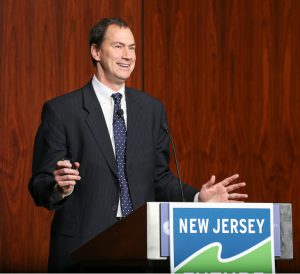New Jersey Future Blog
Forum Feature: Federal Redevelopment Tools: Existential Threats, and a Few Opportunities
March 20th, 2017 by Elaine Clisham
How will the new presidential administration’s policies affect redevelopment at the state level?
At New Jersey Future’s annual Redevelopment Forum, Smart Growth America President and Chief Executive Officer Geoff Anderson provided an overview of where he thought the threats were, and where some potential opportunities lie.
Mr. Anderson (presentation) began with some stage-setting. He highlighted several of the new administration’s stated priorities that come with hefty price tags, including tax reform and an anticipated infrastructure spending bill, while at the same time noting a strong reluctance among federal lawmakers to raising any new money. That means, he said, money for the administration’s priorities will have to come from somewhere, be it tax credits or cuts in other areas.
The “soft” redevelopment funds, he speculated, would be the biggest targets, projecting that as much as $6 billion could be cut from the Housing and Urban Development budget alone. Fully half of that, he said, would be cuts to public housing, and the other half would come from community development block grants (see slide 4 in Geoff Anderson’s presentation). Some of the threatened programs are redevelopment tools, he said, and some help people in communities we’re trying to revitalize. (See slides 6 thru 10 for an overview of how these cuts would play out in New Jersey.) Cuts of this magnitude, he said, would present an existential threat to federal redevelopment tools.
Mr. Anderson expressed particular concern about the Gateway tunnel project, which requires state matching funds for any federal investment. Those funds are not yet secure, he reminded the audience, and as long as there is no state match, federal funds for the project are at risk.
However, he said, there are programs he believes are of interest to the new administration, and where he anticipates funding would be maintained, including:
- Fixing America’s Surface Transportation, or FAST Act, which, he noted, is transportation money, but can help with redevelopment. He listed locational criteria for projects that would help secure access to FAST Act funds, which come with low interest rates and a favorable repayment timeline. (See slide 13.)
- Railroad Rehabilitation and Improvement Financing, or RRIF, is another potential funding opportunity for projects near commuter rail, he said, and is often under-used. Projects eligible for RRIF funds need at least one public-sector partner, but others can be all private. (See slides 14 and 15 for details on who is eligible and financing requirements.)
- Transportation Infrastructure Finance and Innovation Act, or TIFIA, which focuses on transit rather than commuter rail projects. There are more hurdles to clear to secure TIFIA financing, including a requirement for a dedicated revenue source and stricter credit standards. (See slide 17 for details on who is eligible and what the requirements are.)
Mr. Anderson underscored how important it is for experts at the local level to get involved and stay involved, because, he said, there is an enormous disconnect between those who are trying to govern at the federal level according to a particular philosophy or ideology and those working on the ground locally. He finished by expressing the hope that, despite any threats at the federal level, local expertise can help make sure some right things will happen.

















